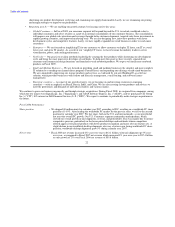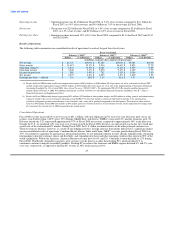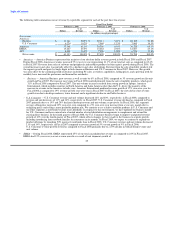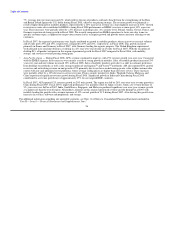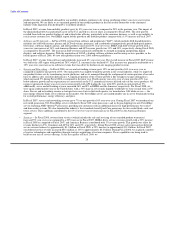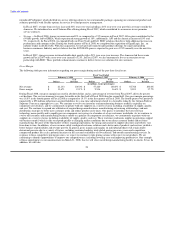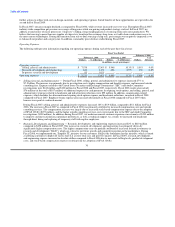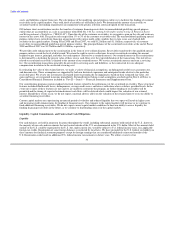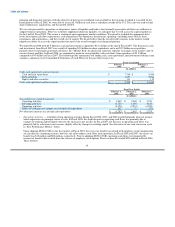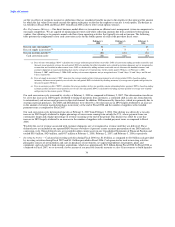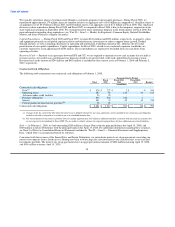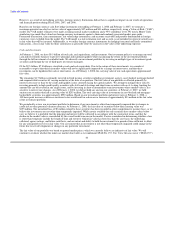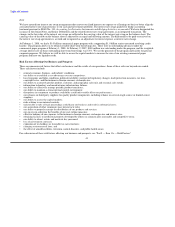Dell 2007 Annual Report Download - page 35
Download and view the complete annual report
Please find page 35 of the 2007 Dell annual report below. You can navigate through the pages in the report by either clicking on the pages listed below, or by using the keyword search tool below to find specific information within the annual report.
Table of Contents
We manage our research, development, and engineering spending by targeting those innovations and products most valuable to our
customers, and by relying upon the capabilities of our strategic partners. We will continue to invest in research, development, and
engineering activities to support our growth and to provide for new, competitive products. We obtained 1,954 worldwide patents and
have applied for 2,196 additional worldwide patents at February 1, 2008.
• In-Process Research and Development — We recognized in-process research and development ("IPR&D") charges in connection
with acquisitions accounted for as business combinations, as more fully described in Note 7 of Notes to Consolidated Financial
Statements included in "Part II — Item 8 — Financial Statements and Supplementary Data." During Fiscal 2008, we recorded
IPR&D charges of $83 million. Prior to Fiscal 2008, there were no IPR&D charges related to acquisitions.
On May 31, 2007, we announced that we had initiated a comprehensive review of costs across all processes and organizations with the
goal to simplify structure, eliminate redundancies, and better align operating expenses with the current business environment and
strategic growth opportunities. These efforts are continuing. Since this announcement and through the end of Fiscal 2008, we have
reduced headcount by 3,200, excluding acquisitions, and strategically closed some of our facilities. As noted above, we expect to take
further action to continue to reduce our cost structure in Fiscal 2009 to improve our competitiveness and increase productivity.
Stock-Based Compensation
We use the 2002 Long-Term Incentive Plan, amended in December 2007, for stock-based incentive awards. These awards can be in the
form of stock options, stock appreciation rights, stock bonuses, restricted stock, restricted stock units, performance units, or performance
shares.
Stock-based compensation expense totaled $436 million for Fiscal 2008, compared to $368 million and $17 million for Fiscal 2007 and
Fiscal 2006, respectively. The increase in Fiscal 2008 and Fiscal 2007 as compared to Fiscal 2006 is due to the implementation of
SFAS 123(R) and cash payments of $107 million made for expired in-the-money stock options discussed below. We adopted
SFAS 123(R) using the modified prospective transition method under SFAS 123(R) effective the first quarter of Fiscal 2007. Included in
stock-based compensation for Fiscal 2008 and Fiscal 2007 is the fair value of stock-based awards earned during the year, including
restricted stock, restricted stock units, and stock options, as well as the discount associated with stock purchased under our employee
stock purchase plan ("ESPP"). The ESPP was discontinued effective February 2008 as part of an overall assessment of our benefits
strategy. Prior to the adoption of SFAS 123(R), we accounted for our equity incentive plans under the intrinsic value recognition and
measurement principles of Accounting Principles Board Opinion (APB) No. 25, Accounting for Stock Issued to Employees, ("APB 25")
and its related interpretations. Accordingly, stock-based compensation for the fair value of employee stock options with no intrinsic value
at the grant date and the discount associated with the stock purchase under our ESPP was not recognized in net income prior to Fiscal
2007. For further discussion on stock-based compensation, see Note 5 of Notes to Consolidated Financial Statements included in
"Part II — Item 8 — Financial Statements and Supplementary Data."
At February 1, 2008 there was $93 million and $600 million of total unrecognized stock-based compensation expense related to stock
options and non-vested restricted stock, respectively, with the unrecognized stock-based compensation expense expected to be recognized
over a weighted-average period of 2.0 years and 1.9 years, respectively. At February 2, 2007 there was $139 million and $356 million of
total unrecognized stock-based compensation expense related to stock options and non-vested restricted stock, respectively, with the
unrecognized stock-based compensation expense expected to be recognized over a weighted-average period of 1.7 years and 2.4 years,
respectively.
Due to our inability to timely file our Annual Report on Form 10-K for Fiscal 2007, we suspended the exercise of employee stock
options, the vesting of restricted stock units, and the purchase of shares under the ESPP on April 4, 2007. As a result, we agreed to pay
cash to current and former employees who held in-the-money stock options (options that had an exercise price less than the then current
market price of the stock) that expired during the period of unexercisability. We made payments of approximately $107 million in Fiscal
2008 relating to expired in-the-money stock options. We are now current in our periodic reporting obligations and, accordingly, are
permitting the
31



